
|
It brightened very rapidly. Now it is very bright as 8.9 mag (Sept. 11, Chris Wyatt). It stays bright as 8-9 mag until October. The condition is bad in this apparition. In the Southern Hemisphere, it stays observable after this while the comet will be fading. But it stays locating low. It is not observable after this in the Northern Hemisphere.
Date(TT) R.A. (2000) Decl. Delta r Elong. m1 Best Time(A, h)
Oct. 9 11 4.47 -27 16.7 1.896 1.208 34 8.9 4:37 (298, -7)
Oct. 16 11 29.90 -31 42.6 1.946 1.265 34 9.2 4:42 (303, -9)
|
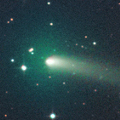
|
Now it is bright as 10.1 mag (Oct. 5, Carlos Labordena). It will brighten up to 9 mag, and will be observable in good condition in winter.
Date(TT) R.A. (2000) Decl. Delta r Elong. m1 Best Time(A, h)
Oct. 9 5 35.06 23 16.1 0.468 1.248 111 10.1 4:24 ( 0, 78)
Oct. 16 6 7.23 24 33.6 0.447 1.230 110 9.8 4:29 ( 0, 80)
|
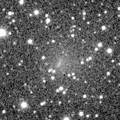
|
Now it is bright as 11.6 mag (Oct. 4, Carlos Labordena). It is observable at 10 mag in good condition from October to December. In the Northern Hemisphere, it locates somewhat low at the high light.
Date(TT) R.A. (2000) Decl. Delta r Elong. m1 Best Time(A, h)
Oct. 9 19 13.82 -29 33.9 0.939 1.377 90 10.3 18:57 ( 13, 24)
Oct. 16 19 41.27 -30 51.3 0.985 1.393 89 10.1 18:48 ( 10, 23)
|
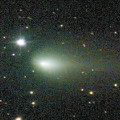
|
Now it is bright as 11.2 mag (Oct. 5, Carlos Labordena). It stays observable at 10-11 mag in excellent condition from summer to autumn.
Date(TT) R.A. (2000) Decl. Delta r Elong. m1 Best Time(A, h)
Oct. 9 6 17.28 15 7.7 1.130 1.648 101 10.3 4:37 (339, 69)
Oct. 16 6 28.94 14 4.7 1.094 1.663 105 10.3 4:42 (354, 69)
|
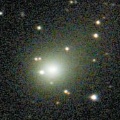
|
Now it is 10.8 mag (Oct. 5, Carlos Labordena). It stays bright as 10 mag until spring for a long time. In the Northern Hemisphere, it stays observable in good condition for a long time. In the Southern Hemisphere, it locates extremely low until November.
Date(TT) R.A. (2000) Decl. Delta r Elong. m1 Best Time(A, h)
Oct. 9 7 36.27 42 27.7 3.565 3.653 87 10.7 4:37 (243, 67)
Oct. 16 7 40.67 41 52.6 3.454 3.639 92 10.6 4:42 (241, 73)
|

|
It brightened up to 9.5 mag in early summer (June 27, Marco Goiato). Now it is fading. But it is bright as 11.4 mag still now (Oct. 4, Carlos Labordena). It will be unobservable soon in the Northern Hemisphere, or in November in the Southern Hemisphere.
Date(TT) R.A. (2000) Decl. Delta r Elong. m1 Best Time(A, h)
Oct. 9 16 34.03 -25 45.8 2.734 2.313 55 11.4 18:57 ( 47, 11)
Oct. 16 16 49.19 -27 8.4 2.833 2.352 51 11.6 18:48 ( 47, 9)
|
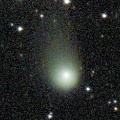
|
Now it is bright as 11.6 mag (Oct. 3, Osamu Miyazaki). It is expected to be observable at 5-6 mag for a long time from 2022 to 2023. In the Northern Hemisphere, it is not observable at the high light from 2022 autumn to 2023 summer. In the Southern Hemisphere, it stays low for a while. But it will be observable in good condition at the high light.
Date(TT) R.A. (2000) Decl. Delta r Elong. m1 Best Time(A, h)
Oct. 9 17 2.24 24 50.8 5.441 5.134 67 11.8 18:57 ( 89, 49)
Oct. 16 17 5.04 23 30.9 5.448 5.074 63 11.7 18:48 ( 89, 45)
|
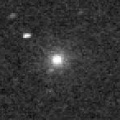
|
It was observed at 9-10 mag from late July to early August. Now it is not observable. It will appear in the morning sky in December, but it will be fainter than 15 mag at that time.
Date(TT) R.A. (2000) Decl. Delta r Elong. m1 Best Time(A, h)
Oct. 9 13 10.05 0 13.6 2.281 1.295 7 11.9 18:57 ( 98,-12)
Oct. 16 13 28.85 -2 43.9 2.377 1.390 6 12.3 18:48 ( 96,-14)
|

|
Now it is 12.3 mag (Oct. 4, Michael Jager). It will approach to Earth down to 0.2 a.u. in December, and it is expected to brighten up to 4 mag. In the Northern Hemisphere, it stays observable in good condition for a long time until December while the comet is brightening gradually. In the Southern Hemisphere, it is not observable until mid December.
Date(TT) R.A. (2000) Decl. Delta r Elong. m1 Best Time(A, h)
Oct. 9 11 25.94 36 53.9 2.240 1.740 48 12.7 4:37 (241, 24)
Oct. 16 11 32.84 36 13.8 2.048 1.635 51 12.2 4:42 (244, 28)
|
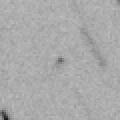
|
Now it is 13.7 mag (Oct. 6, Chris Wyatt). It will brighten rapidly up to 9 mag in winter. It will be observable in good condition. In the Southern Hemisphere, it is observable in excellent condition. In the Northren Hemisphere, it is not observable until November.
Date(TT) R.A. (2000) Decl. Delta r Elong. m1 Best Time(A, h)
Oct. 9 23 17.94 -57 57.3 1.220 1.852 112 12.6 22:05 ( 0, -3)
Oct. 16 23 10.64 -56 40.6 1.210 1.802 109 12.3 21:30 ( 0, -1)
|
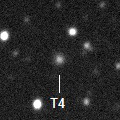
|
Now it is 13.4 mag (Sept. 29, N. Paul, E. Cortes). It is expected to brighten up to 11.5 mag in 2022. In the Southern Hemisphere, it stas observable in good condition for a long time, although it became extremely low temporarily from August to September. In the Northern Hemisphere, it is not observable until November.
Date(TT) R.A. (2000) Decl. Delta r Elong. m1 Best Time(A, h)
Oct. 9 10 51.14 -24 32.5 5.472 4.694 35 13.3 4:37 (298, -3)
Oct. 16 10 58.57 -24 58.8 5.414 4.670 38 13.2 4:42 (302, 1)
|
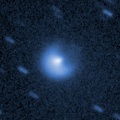
|
Major outburst occured on Sept. 25. Now it is very bright as 11.0 mag (Oct. 5, Osamu Miyazaki).
Date(TT) R.A. (2000) Decl. Delta r Elong. m1 Best Time(A, h)
Oct. 9 4 57.44 32 2.1 5.376 5.920 118 13.4 3:48 ( 0, 87)
Oct. 16 4 56.48 32 8.3 5.286 5.922 125 13.4 3:19 ( 0, 87)
|

|
It brightened very rapidly up to 10.7 mag in July (July 20, Osamu Miyazaki). Now it is fading. It has already faded down to 15.9 mag (Oct. 8, Toshihiko Ikemura, Hirohisa Sato). It stays observable in the morning sky for a long time.
Date(TT) R.A. (2000) Decl. Delta r Elong. m1 Best Time(A, h)
Oct. 9 8 23.65 26 8.7 1.500 1.552 73 13.7 4:37 (274, 55)
Oct. 16 8 35.03 25 57.8 1.496 1.618 78 14.2 4:42 (278, 60)
|

|
It brightened up to 12.3 mag from spring to summer (June 15, Marco Goiato). Now it is fading. It has already faded down to 13.8 mag (Sept. 8, Chris Wyatt). Now it is not observable. It will be observable again at 14 mag in November in the Northern Hemisphere, or in January in the Southern Hemisphere.
Date(TT) R.A. (2000) Decl. Delta r Elong. m1 Best Time(A, h)
Oct. 9 13 58.05 -2 37.8 4.676 3.723 15 13.8 18:57 ( 89, -4)
Oct. 16 14 1.26 -2 19.1 4.723 3.751 11 13.8 18:48 ( 92, -7)
|
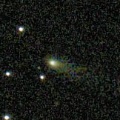
|
Now it is 13.1 mag (Oct. 8, Toshihiko Ikemura, Hirohisa Sato). It is observable at 14 mag in excellent condition in autumn.
Date(TT) R.A. (2000) Decl. Delta r Elong. m1 Best Time(A, h)
Oct. 9 0 22.00 -1 37.1 0.737 1.727 168 14.2 23:09 ( 0, 53)
Oct. 16 0 21.52 -2 28.2 0.741 1.715 160 14.1 22:41 ( 0, 53)
|

|
Now it is not observable. In the Southern Hemisphere, it will appear in the morning sky at 11 mag in late January, then it stays observable at 11 mag until June. In the Northern Hemisphere, it will appear in the morning sky in December, but it stays locating extremely low for a long time.
Date(TT) R.A. (2000) Decl. Delta r Elong. m1 Best Time(A, h)
Oct. 9 13 25.39 -5 28.7 3.169 2.181 6 14.9 18:57 ( 91,-12)
Oct. 16 13 39.35 -6 51.5 3.132 2.139 4 14.7 18:48 ( 91,-14)
|

|
Now it is 14.5 mag (Oct. 6, Chris Wyatt). It stays 14-15 mag until the end of 2021. In the Southern Hemisphere, it stays observable in good condition for a long time. It locates low in the Northern Hemisphere.
Date(TT) R.A. (2000) Decl. Delta r Elong. m1 Best Time(A, h)
Oct. 9 22 32.28 -28 38.9 3.912 4.625 130 14.9 21:19 ( 0, 27)
Oct. 16 22 28.85 -27 37.8 4.011 4.646 124 15.0 20:48 ( 0, 28)
|

|
Now it is 14.3 mag (Oct. 1, Toshihiko Ikemura, Hirohisa Sato). It will be fading after this. In the Northern Hemisphere, it stays observable in good condition for a long time, although it becomes extremely low temporarily in November. In the Southern Hemisphere, it is not observable until late January.
Date(TT) R.A. (2000) Decl. Delta r Elong. m1 Best Time(A, h)
Oct. 9 16 8.44 19 36.5 2.749 2.300 53 14.9 18:57 ( 90, 35)
Oct. 16 16 7.02 18 47.9 2.837 2.306 48 15.0 18:48 ( 92, 31)
|

|
Now it is 14.9 mag (Oct. 6, Chris Wyatt). It stays 13-14 mag from 2020 to 2021. It will be observable in good condition after this in the Southern Hemisphere. It locates low in the Northern Hemisphere.
Date(TT) R.A. (2000) Decl. Delta r Elong. m1 Best Time(A, h)
Oct. 9 19 9.38 -34 34.5 2.963 3.109 88 14.9 18:57 ( 13, 19)
Oct. 16 19 16.82 -34 16.1 3.071 3.123 83 15.1 18:48 ( 15, 19)
|

|
It brightened up to 9.7 mag in June (June 4, Michael Jager). Now it is fading. It has already faded down to 14.1 mag (Sept. 11, Chris Wyatt). In the Southern Hemisphere, it stays observable in excellent condition for a long time. In the Northern Hemisphere, it becomes extremely low after this.
Date(TT) R.A. (2000) Decl. Delta r Elong. m1 Best Time(A, h)
Oct. 9 23 15.86 -45 23.4 1.230 1.968 123 15.0 22:03 ( 0, 10)
Oct. 16 23 15.58 -43 24.8 1.327 2.022 120 15.4 21:35 ( 0, 12)
|
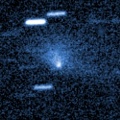
|
It brightened up to 10.1 mag in spring (Apr. 10, Marco Goiato). Now it is fading. It has already faded down to 16.3 mag (Oct. 1, Toshihiko Ikemura, Hirohisa Sato). It stays observable in good condition for a long time after this while the comet will fading.
Date(TT) R.A. (2000) Decl. Delta r Elong. m1 Best Time(A, h)
Oct. 9 4 54.90 6 54.1 1.672 2.349 121 15.0 3:45 ( 0, 62)
Oct. 16 4 52.57 6 29.9 1.644 2.392 128 15.1 3:15 ( 0, 62)
|

|
It will brighten up to 12 mag from winter to spring. Now it is not observable. In the Northern Hemisphere, it will appear in the morning sky at 14 mag in November. In the Southern Hemisphere, it is not observable until January.
Date(TT) R.A. (2000) Decl. Delta r Elong. m1 Best Time(A, h)
Oct. 9 12 12.80 6 12.1 3.000 2.063 16 15.2 4:37 (261, -2)
Oct. 16 12 27.57 4 31.5 2.938 2.024 19 15.0 4:42 (265, 1)
|
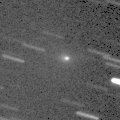
|
Now it is 14.3 mag (Oct. 4, Michael Jager). It stays 15 mag until November. It will be observable in excellent condition in the Northern Hemisphere. It locates somewhat low in the Southern Hemisphere.
Date(TT) R.A. (2000) Decl. Delta r Elong. m1 Best Time(A, h)
Oct. 9 6 30.49 26 14.1 1.213 1.685 98 15.1 4:37 (310, 77)
Oct. 16 6 43.69 27 16.0 1.171 1.698 102 15.1 4:42 (325, 81)
|
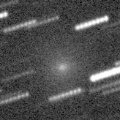
|
Bright new periodic comet. Now it is 14.5 mag (Oct. 8, Toshihiko Ikemura, Hirohisa Sato). It stays observable in good condition for a long time. It stays 14-15 mag until November. Juan Jose Gonzalez reported it is very bright as 11.8 mag on Oct. 7.
Date(TT) R.A. (2000) Decl. Delta r Elong. m1 Best Time(A, h)
Oct. 9 9 6.30 10 53.2 1.499 1.322 60 15.1 4:37 (286, 39)
Oct. 16 9 24.88 8 32.8 1.500 1.354 61 15.2 4:42 (291, 40)
|

|
Now it is 14.8 mag (Oct. 6, Chris Wyatt). It was expected to brighten up to 13 mag from spring to summer. But actually, it is fainter than originally expected. It will be fading slowly after this. In the Southern Hemisphere, it stays observable in good condition for a long time. In the Northern Hemisphere, it is not observable until July in 2022.
Date(TT) R.A. (2000) Decl. Delta r Elong. m1 Best Time(A, h)
Oct. 9 21 7.75 -78 7.0 3.585 3.727 90 15.2 19:57 ( 0,-23)
Oct. 16 21 17.79 -76 21.4 3.645 3.744 87 15.2 19:40 ( 0,-21)
|

|
Now it is 15.2 mag (Sept. 8, Chris Wyatt). It stays at 14-15 mag for a long time from 2021 to 2022. It will be unobservable from November to January.
Date(TT) R.A. (2000) Decl. Delta r Elong. m1 Best Time(A, h)
Oct. 9 16 23.51 -19 16.5 5.554 4.997 51 15.2 18:57 ( 54, 14)
Oct. 16 16 25.47 -20 7.9 5.645 4.995 45 15.2 18:48 ( 56, 10)
|

|
Now it is 16.0 mag (Aug. 16, iTelescope Observatory, Siding Spring). It is expected to brighten up to 13 mag in 2022. In the Southern Hemisphere, it stays observable in good condition for a long time, although it becomes extremely low temporarily from September to October. In the Northern Hemisphere, it is not observable for a while.
Date(TT) R.A. (2000) Decl. Delta r Elong. m1 Best Time(A, h)
Oct. 9 12 25.17 -30 27.5 4.819 3.940 25 15.4 4:37 (291,-24)
Oct. 16 12 28.59 -31 45.4 4.771 3.902 26 15.3 4:42 (296,-19)
|

|
Now it is 15.8 mag (Oct. 4, Thomas Lehmann). In the Northern Hemisphere, it is not observable now. It will be unobservable soon also in the Southern Hemisphere. It will appear in the morning sky at 15 mag in January. Then It will brighten up to 13 mag in 2022 summer.
Date(TT) R.A. (2000) Decl. Delta r Elong. m1 Best Time(A, h)
Oct. 9 14 36.16 -13 57.9 4.186 3.312 25 15.5 18:57 ( 75, -3)
Oct. 16 14 45.63 -14 51.6 4.210 3.299 20 15.5 18:48 ( 75, -5)
|

|
Now it is 16.2 mag (Oct. 1, Thomas Lehmann). It will brighten up to 12.5 mag in 2022 summer. In the Southern Hemisphere, it stays observable in excellent condition for a long time. In the Northern Hemisphere, it is not observable until August in 2022.
Date(TT) R.A. (2000) Decl. Delta r Elong. m1 Best Time(A, h)
Oct. 9 2 43.48 -74 6.1 4.165 4.418 98 15.5 1:34 ( 0,-19)
Oct. 16 2 11.61 -75 25.8 4.162 4.371 95 15.5 0:35 ( 0,-20)
|

|
Now it is 14.8 mag (Oct. 3, Michael Jager). It stays 15 mag until October, and it is observable in good condition.
Date(TT) R.A. (2000) Decl. Delta r Elong. m1 Best Time(A, h)
Oct. 9 23 2.69 -16 52.8 1.422 2.303 143 15.5 21:50 ( 0, 38)
Oct. 16 23 2.53 -17 11.2 1.479 2.307 136 15.6 21:22 ( 0, 38)
|
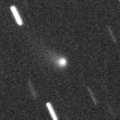
|
Now it is 15.4 mag (Sept. 8, Thomas Lehmann). In the Northern Hemisphere, it stays observable at 15-16 mag for a long time until early 2022, although it becomes extremely low temporarily from September to October. In the Southern Hemisphere, it is not observable until the end of 2021.
Date(TT) R.A. (2000) Decl. Delta r Elong. m1 Best Time(A, h)
Oct. 9 12 57.43 27 48.5 3.822 3.045 33 15.7 4:37 (238, 3)
Oct. 16 13 1.17 26 9.4 3.815 3.057 35 15.7 4:42 (243, 7)
|
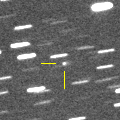
|
It brightened rapidly. Now it is 15.0 mag (Oct. 4, D. Buczynski). It will be observable at 15 mag in excellent condition in winter.
Date(TT) R.A. (2000) Decl. Delta r Elong. m1 Best Time(A, h)
Oct. 9 7 55.15 23 57.7 2.434 2.456 79 15.8 4:37 (283, 60)
Oct. 16 8 4.54 23 12.4 2.348 2.456 84 15.7 4:42 (290, 64)
|

|
Now it is 16.7 mag (Sept. 29, Thomas Lehmann). It will brightens rapidly. And it is expected to be observable at 12-13 mag in good condition from December to February.
Date(TT) R.A. (2000) Decl. Delta r Elong. m1 Best Time(A, h)
Oct. 9 21 43.48 -6 47.8 0.774 1.609 129 16.1 20:31 ( 0, 48)
Oct. 16 21 41.20 -7 52.7 0.770 1.550 122 15.7 20:01 ( 0, 47)
|

|
Now it is 15.7 mag (Oct. 2, Toshihiko Ikemura, Hirohisa Sato). It is expected to brighten up to 11 mag in 2023. In the Northern Hemisphere, it stays observable in good condition for a long time. It is not observable in the Southern Hemisphere.
Date(TT) R.A. (2000) Decl. Delta r Elong. m1 Best Time(A, h)
Oct. 9 16 6.66 36 25.7 6.274 5.862 61 15.8 18:57 (110, 42)
Oct. 16 16 7.97 35 29.7 6.271 5.818 58 15.7 18:48 (111, 38)
|
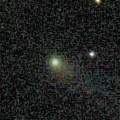
|
Now it is 16.0 mag (Oct. 8, Toshihiko Ikemura, Hirohisa Sato). It stays observable in good condition for a long time. But it will be fading after this.
Date(TT) R.A. (2000) Decl. Delta r Elong. m1 Best Time(A, h)
Oct. 9 22 56.95 1 28.0 1.272 2.193 149 15.8 21:44 ( 0, 57)
Oct. 16 22 55.14 1 44.1 1.325 2.201 142 15.9 21:15 ( 0, 57)
|

|
Now it is 16.0 mag (Oct. 1, Toshihiko Ikemura, Hirohisa Sato). It will be fading after this, and it will be fainter than 18 mag in December. In the Northern Hemisphere, it stays observable in good condition for a long time. In the Southern Hemisphere, it will be getting lower gradually after this.
Date(TT) R.A. (2000) Decl. Delta r Elong. m1 Best Time(A, h)
Oct. 9 7 41.76 31 24.3 1.390 1.623 83 15.9 4:37 (271, 66)
Oct. 16 7 59.10 32 34.8 1.361 1.649 87 16.0 4:42 (270, 69)
|
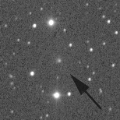
|
It brightened up to 14.2 mag in early summer (June 10, Thomas Lehmann). Now it is fading. In the Northern Hemisphere, it is appearing in the morning sky. In the Southern Hemisphere, it will never be observable again.
Date(TT) R.A. (2000) Decl. Delta r Elong. m1 Best Time(A, h)
Oct. 9 12 22.25 25 7.9 3.003 2.225 32 15.9 4:37 (245, 7)
Oct. 16 12 37.89 26 6.9 2.986 2.265 36 15.9 4:42 (246, 11)
|
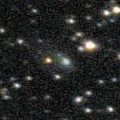
|
Now it is 15.4 mag (Oct. 1, Toshihiko Ikemura, Hirohisa Sato). It is expected to brighten up to 11 mag from spring to summer in 2022. In the Southen Hemisphere, it locates somewhat low in 2021, but it will be observable in good condition at the high light for a long time. In the Northern Hemisphere, it is observable in good condition in 2021, but it will not be observable at the high light.
Date(TT) R.A. (2000) Decl. Delta r Elong. m1 Best Time(A, h)
Oct. 9 18 35.75 13 27.9 3.349 3.430 86 16.0 18:57 ( 50, 60)
Oct. 16 18 35.34 11 9.6 3.392 3.366 80 15.9 18:48 ( 54, 55)
|
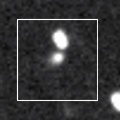
|
Now it is 16.6 mag (July 29, Thomas Lehmann). It is expected to brighten up to 10 mag in 2023. In the Northern Hemisphere, it stays observable in good condition until 2023 autumn, although it became extremely low temporarily in September. In the Southern Hemipshere, it stays unobservable until 2023 summer.
Date(TT) R.A. (2000) Decl. Delta r Elong. m1 Best Time(A, h)
Oct. 9 12 32.45 33 47.8 6.888 6.161 40 16.1 4:37 (236, 11)
Oct. 16 12 36.16 33 51.6 6.782 6.106 44 16.0 4:42 (239, 16)
|
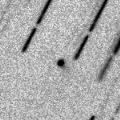
|
Michael Jager detected its cometary activity on Sept. 25. Now it is bright as 16.2 mag (Oct. 3, Michael Jager). It approaches to Earth down to 0.35 a.u. in early October, and it is observable at 16 mag in excellent condition.
Date(TT) R.A. (2000) Decl. Delta r Elong. m1 Best Time(A, h)
Oct. 9 0 9.25 3 38.3 0.357 1.350 167 16.0 22:57 ( 0, 58)
Oct. 16 0 22.74 -1 53.4 0.372 1.355 161 16.3 22:43 ( 0, 53)
|

|
Outburst occured in early August, and it brightened up to 14.1 mag (Aug. 7, Michael Jager). Now it is fading. It has already faded down to 17.5 mag (Oct. 8, Toshihiko Ikemura, Hirohisa Sato). In the Northern Hemisphere, it stays observable in good condition. In the Southern Hemipsphere, it stays locating extremely low after this.
Date(TT) R.A. (2000) Decl. Delta r Elong. m1 Best Time(A, h)
Oct. 9 5 56.45 46 0.7 2.245 2.683 105 16.2 4:37 (189, 79)
Oct. 16 5 59.20 46 42.2 2.194 2.712 110 16.4 4:22 (180, 78)
|

|
Now it is 15.8 mag (Oct. 2, Toshihiko Ikemura, Hirohisa Sato). It will be unobservable in November.
Date(TT) R.A. (2000) Decl. Delta r Elong. m1 Best Time(A, h)
Oct. 9 16 47.84 -8 45.5 5.343 4.873 57 16.2 18:57 ( 57, 26)
Oct. 16 16 52.21 -8 20.6 5.434 4.877 51 16.2 18:48 ( 60, 23)
|
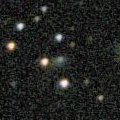
|
Now it is 17.5 mag (Oct. 3, Toshihiko Ikemura, Hirohisa Sato). It will brighten up to 15.5 mag in winter. In the Northern Hemisphere, it stays observable in good condition for a long time. It is not observable at all in the Southern Hemisphere.
Date(TT) R.A. (2000) Decl. Delta r Elong. m1 Best Time(A, h)
Oct. 9 15 38.17 64 19.2 3.252 3.172 76 16.3 18:57 (148, 41)
Oct. 16 15 38.73 63 29.7 3.223 3.147 76 16.2 18:48 (147, 39)
|
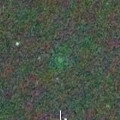
|
It brightened up to 4 mag in major outburst in 2016. In this apparition, it brightened up to 10.5 mag in early August (Aug. 8, Rob Kaufman). Now it is fading rapidly. It has already faded down to 14.0 mag (Aug. 31, Chris Wyatt). In the Southern Hemisphere, it stays locating low in the evening sky until October. In the Northern Hemisphere, it stays locating extremely low.
Date(TT) R.A. (2000) Decl. Delta r Elong. m1 Best Time(A, h)
Oct. 9 15 30.65 -12 8.4 2.203 1.547 38 16.2 18:57 ( 68, 9)
Oct. 16 15 52.35 -13 12.3 2.293 1.610 36 16.9 18:48 ( 67, 9)
|
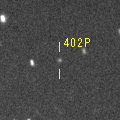
|
First return of a new periodic comet observed at 16 mag from 2003 to 2004. Now it is 17.0 mag (Sept. 27, ATLAS-MLO, Mauna Loa). It will brighten up to 16 mag in winter, and it will be observable in excellent condition.
Date(TT) R.A. (2000) Decl. Delta r Elong. m1 Best Time(A, h)
Oct. 9 6 35.89 1 15.1 3.733 3.956 95 16.3 4:37 (339, 54)
Oct. 16 6 38.41 1 4.2 3.635 3.953 101 16.3 4:42 (352, 56)
|
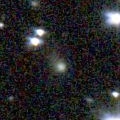
|
Now it is 16.2 mag (Oct. 1, Toshihiko Ikemura, Hirohisa Sato). It is expected to brighten up to 11 mag in 2023. In the Northern Hemisphere, it is observable in good condition in 2021. But it is observable only until November in 2022. In the Southern Hemisphere, it locates extremely low in 2021. But it will be observable in good condition at the high light.
Date(TT) R.A. (2000) Decl. Delta r Elong. m1 Best Time(A, h)
Oct. 9 17 29.21 29 29.5 6.248 6.053 74 16.4 18:57 ( 92, 56)
Oct. 16 17 31.46 28 13.6 6.266 6.004 70 16.3 18:48 ( 92, 52)
|

|
It was expected to brighten up to 14.5 mag from spring to summer. But actually, it is fainter than expected. Now it is 17.7 mag (July 4, Mount John Observatory, Lake Tekapo). In the Southern Hemisphere, it stays observable for a long time. In the Northern Hemisphere, it is not observable after this.
Date(TT) R.A. (2000) Decl. Delta r Elong. m1 Best Time(A, h)
Oct. 9 11 28.95 -51 36.8 3.744 3.180 49 16.4 4:37 (317,-24)
Oct. 16 11 36.05 -51 32.0 3.798 3.219 48 16.5 4:42 (319,-21)
|

|
Now it is 16.2 mag (Sept. 22, Thomas Lehmann). It is observable at 16 mag from 2020 to 2021. It locates low in the Southern Hemisphere.
Date(TT) R.A. (2000) Decl. Delta r Elong. m1 Best Time(A, h)
Oct. 9 21 41.30 33 31.1 5.491 6.145 127 16.4 20:28 ( 0, 89)
Oct. 16 21 37.73 31 54.5 5.557 6.157 122 16.5 19:57 ( 0, 87)
|

|
Now it is 16.4 mag (Oct. 4, ATLAS-MLO, Mauna Loa). It stays 16.5 mag until October.
Date(TT) R.A. (2000) Decl. Delta r Elong. m1 Best Time(A, h)
Oct. 9 17 44.24 -20 47.8 1.771 1.722 70 16.4 18:57 ( 37, 25)
Oct. 16 18 3.06 -20 59.1 1.821 1.720 68 16.5 18:48 ( 37, 24)
|

|
It brightened up to 11.6 mag in winter (Feb. 18, Thomas Lehmann). Now it is fading. It has already faded down to 15.8 mag (Sept. 15, Thomas Lehmann). In the Southern Hemisphere, it stays observable in good condition after this. In the Northern Hemisphere, it will never be observable after this.
Date(TT) R.A. (2000) Decl. Delta r Elong. m1 Best Time(A, h)
Oct. 9 4 0.13 -70 2.7 3.773 4.033 97 16.5 2:50 ( 0,-15)
Oct. 16 3 35.35 -70 26.8 3.843 4.097 97 16.5 1:58 ( 0,-15)
|
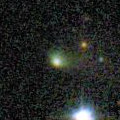
|
Now it is 15.9 mag (Oct. 1, Toshihiko Ikemura, Hirohisa Sato). It will be fading after this, and it will be fainter than 18 mag in November.
Date(TT) R.A. (2000) Decl. Delta r Elong. m1 Best Time(A, h)
Oct. 9 1 4.49 -13 53.7 1.960 2.918 159 16.7 23:51 ( 0, 41)
Oct. 16 1 1.40 -14 23.9 2.013 2.952 156 16.8 23:20 ( 0, 41)
|
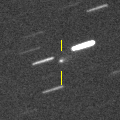
|
Now it is 16.6 mag (Oct. 8, Toshihiko Ikemura, Hirohisa Sato). It stays observable at 17 mag from autumn to winter. In the Northern Hemisphere, it stays observable in good condition. In the Southern Hemisphere, it stays extremely low until November.
Date(TT) R.A. (2000) Decl. Delta r Elong. m1 Best Time(A, h)
Oct. 9 9 55.55 18 0.3 2.228 1.778 50 16.7 4:37 (270, 33)
Oct. 16 10 12.41 16 10.4 2.184 1.780 53 16.7 4:42 (274, 35)
|
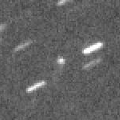
|
Now it is 17.0 mag (Oct. 2, Toshihiko Ikemura, Hirohisa Sato). It will brighten up to 16 mag in 2022. In the Northern Hemisphere, it stays observable in good condition for a long time. In the Southern Hemisphere, it is not observable until 2023.
Date(TT) R.A. (2000) Decl. Delta r Elong. m1 Best Time(A, h)
Oct. 9 8 59.21 57 26.2 4.213 4.151 79 16.8 4:37 (220, 51)
Oct. 16 9 7.99 59 16.6 4.095 4.125 84 16.7 4:42 (215, 54)
|
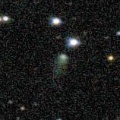
|
Now it is 16.6 mag (Oct. 3, Toshihiko Ikemura, Hirohisa Sato). It stays at 16-17 mag from 2020 to 2021. In the Northern Hemisphere, it stays observable in good condition for a long time. In the Southern Hemisphere, it is not observable after this.
Date(TT) R.A. (2000) Decl. Delta r Elong. m1 Best Time(A, h)
Oct. 9 18 19.45 48 42.2 8.879 8.907 88 16.7 18:57 (132, 66)
Oct. 16 18 19.79 48 19.6 8.923 8.913 86 16.8 18:48 (129, 63)
|
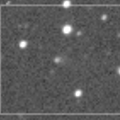
|
First return of a new periodic comet which brightened up to 17 mag in 2006. Now it is 17.4 mag (Sept. 27, N. Paul, E. Cortes). It stays 17 mag from 2021 to 2022.
Date(TT) R.A. (2000) Decl. Delta r Elong. m1 Best Time(A, h)
Oct. 9 21 30.07 -61 47.3 2.827 3.177 101 16.8 20:18 ( 0, -7)
Oct. 16 21 32.11 -59 59.5 2.878 3.167 97 16.8 19:53 ( 0, -5)
|
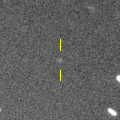
|
Now it is 16.4 mag (Sept. 27, ATLAS-MLO, Mauna Loa). It continues brightening even after the perihelion passage. It stays observable at 17 mag in good condition for a while.
Date(TT) R.A. (2000) Decl. Delta r Elong. m1 Best Time(A, h)
Oct. 9 5 11.87 -13 51.6 3.177 3.696 113 16.9 4:02 ( 0, 41)
Oct. 16 5 11.26 -14 31.2 3.127 3.713 118 16.9 3:34 ( 0, 41)
|

|
Now it is 17.7 mag (May 12, ATLAS-HKO, Haleakala). It brightened rapidly. It stays 17 mag for a long time from 2021 to 2022. In the Southern Hemisphere, it stays observable in good condition for a long time. In the Northern Hemisphere, it will be observable only in extremely low sky from autumn to winter.
Date(TT) R.A. (2000) Decl. Delta r Elong. m1 Best Time(A, h)
Oct. 9 9 7.61 -25 13.2 5.800 5.339 58 17.0 4:37 (314, 13)
Oct. 16 9 8.64 -26 44.9 5.721 5.336 62 17.0 4:42 (321, 16)
|
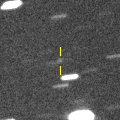
|
Now it is 17.3 mag (Oct. 2, Toshihiko Ikemura, Hirohisa Sato). It will brighten up to 15.5 mag, and will be observable in excellent condition in winter.
Date(TT) R.A. (2000) Decl. Delta r Elong. m1 Best Time(A, h)
Oct. 9 9 12.69 15 13.9 2.331 2.019 59 17.2 4:37 (280, 40)
Oct. 16 9 27.74 14 21.1 2.264 2.014 62 17.1 4:42 (284, 43)
|
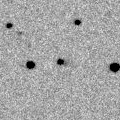
|
Now it is 16.0 mag (Oct. 8, Toshihiko Ikemura, Hirohisa Sato). It is observable at 16-17 mag in good condition in autumn.
Date(TT) R.A. (2000) Decl. Delta r Elong. m1 Best Time(A, h)
Oct. 9 2 26.37 17 6.8 2.870 3.803 155 17.1 1:17 ( 0, 72)
Oct. 16 2 23.49 16 33.3 2.835 3.801 163 17.1 0:47 ( 0, 72)
|

|
Now it is 16.7 mag (Oct. 2, Toshihiko Ikemura, Hirohisa Sato). In the Northern Hemisphere, it stays observable in good condition after this while the comet will be fading. In the Southern Hemisphere, it stays locating extremely low for a long time.
Date(TT) R.A. (2000) Decl. Delta r Elong. m1 Best Time(A, h)
Oct. 9 5 27.14 40 29.0 2.291 2.810 111 17.2 4:18 (180, 85)
Oct. 16 5 26.34 41 8.7 2.263 2.866 117 17.2 3:49 (180, 84)
|

|
Now it is 17.1 mag (Oct. 3, Toshihiko Ikemura, Hirohisa Sato). Fading slowly. In the Northern Hemisphere, it stays observable in good condition for a long time. It is not observable after this in the Southern Hemisphere.
Date(TT) R.A. (2000) Decl. Delta r Elong. m1 Best Time(A, h)
Oct. 9 16 15.68 49 5.2 6.133 5.867 70 17.2 18:57 (127, 46)
Oct. 16 16 17.60 48 36.1 6.186 5.901 68 17.3 18:48 (127, 43)
|

|
Now it is 17.1 mag (Oct. 2, Toshihiko Ikemura, Hirohisa Sato). It will brighten rapidly, and it will be observable at 13.5 mag in good condition from winter to spring.
Date(TT) R.A. (2000) Decl. Delta r Elong. m1 Best Time(A, h)
Oct. 9 8 56.41 20 42.8 3.140 2.864 64 17.4 4:37 (276, 46)
Oct. 16 9 5.82 20 9.3 3.027 2.838 69 17.2 4:42 (281, 51)
|
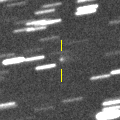
|
Now it is 17.2 mag (Sept. 20, Ken-ichi Kadota). In the Northern Hemisphere, it stays observable at 17 mag in good condition until winter. In the Southern Hemisphere, it stays locating extremely low for a while.
Date(TT) R.A. (2000) Decl. Delta r Elong. m1 Best Time(A, h)
Oct. 9 8 25.91 31 16.3 2.072 2.049 74 17.3 4:37 (265, 57)
Oct. 16 8 37.68 30 8.2 2.023 2.073 78 17.3 4:42 (270, 61)
|

|
Now it is 18.4 mag (Oct. 2, Toshihiko Ikemura, Hirohisa Sato). It stays 17-18 mag for a long time from 2021 to 2022. It is observable in excellent condition in the Northern Hemisphere, It locates somewhat low in the Southern Hemisphere.
Date(TT) R.A. (2000) Decl. Delta r Elong. m1 Best Time(A, h)
Oct. 9 5 16.21 33 53.2 5.031 5.519 114 17.3 4:07 ( 0, 89)
Oct. 16 5 8.96 34 8.4 4.906 5.507 122 17.3 3:32 ( 0, 89)
|

|
Now it is 17.5 mag (Oct. 1, Toshihiko Ikemura, Hirohisa Sato). It is expected to brighten up to 4.5 mag in 2022 April. However, it is not observable at the high light. In the Northern Hemisphere, it stays observable until early February when it brightens up to 14 mag. Then it will appear at 6 mag in mid May, and it stays observable in good condition after that while the comet will be fading. In the Southern Hemisphere, it stays observable until December when it brightens up to 16 mag. But after that, it is not observable until 2022 August.
Date(TT) R.A. (2000) Decl. Delta r Elong. m1 Best Time(A, h)
Oct. 9 22 16.71 20 41.9 2.612 3.424 138 17.4 21:03 ( 0, 76)
Oct. 16 22 10.27 18 57.2 2.584 3.336 132 17.3 20:30 ( 0, 74)
|

|
Now it is 18.4 mag (Oct. 3, Toshihiko Ikemura, Hirohisa Sato). It will be fading slowly.
Date(TT) R.A. (2000) Decl. Delta r Elong. m1 Best Time(A, h)
Oct. 9 16 52.78 -10 32.0 8.631 8.150 58 17.4 18:57 ( 55, 25)
Oct. 16 16 53.65 -10 29.5 8.757 8.178 51 17.5 18:48 ( 58, 22)
|

|
Peculiar asteroid moving along a cometary orbit. It brightens up to 17 mag from September to October. In the Northern Hemisphere, it is observable in excellent condition. It is not observable in the Southern Hemisphere.
Date(TT) R.A. (2000) Decl. Delta r Elong. m1 Best Time(A, h)
Oct. 9 21 25.81 84 49.2 0.679 1.295 99 17.5 20:08 (180, 41)
Oct. 16 21 15.60 77 36.9 0.774 1.406 104 17.8 19:34 (180, 48)
|

|
Now it is 18.4 mag (Sept. 30, ATLAS-MLO, Mauna Loa). It will brighten up to 16.5-17 mag in winter. In its last apparition in 2015, it brightened up to 13 mag.
Date(TT) R.A. (2000) Decl. Delta r Elong. m1 Best Time(A, h)
Oct. 9 21 44.39 -33 1.7 1.518 2.193 119 17.5 20:32 ( 0, 22)
Oct. 16 21 44.76 -32 44.4 1.550 2.151 113 17.5 20:05 ( 0, 22)
|
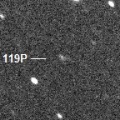
|
Now it is 17.1 mag (Oct. 2, Toshihiko Ikemura, Hirohisa Sato). It will brighten up to 15 mag in 2022 winter. In 2021, it stays observable in good condition while the comet will be brightening gradually.
Date(TT) R.A. (2000) Decl. Delta r Elong. m1 Best Time(A, h)
Oct. 9 22 25.17 -19 8.7 2.281 3.067 134 17.6 21:12 ( 0, 36)
Oct. 16 22 23.34 -19 9.9 2.329 3.041 127 17.5 20:43 ( 0, 36)
|

|
First return of a new periodic comet which brightened up to 17 mag in 2011. Now it is 17.2 mag (Sept. 16, Catalina Sky Survey). It stays observable at 17 mag in good condition until 2022 spring.
Date(TT) R.A. (2000) Decl. Delta r Elong. m1 Best Time(A, h)
Oct. 9 9 52.63 16 12.0 2.076 1.641 50 17.7 4:37 (272, 32)
Oct. 16 10 12.65 14 35.1 2.016 1.621 52 17.6 4:42 (276, 34)
|

|
Now it is 17.7 mag (Oct. 2, H. Nohara). It is expected to brighten up to 11 mag in 2022 summer. In the Northern Hemisphere, it stays observable in good condition until 2022 June when it brightens up to 11 mag. But it is not observable after the high light. In the Souther Hemisphere, it is not observable until 2022 October.
Date(TT) R.A. (2000) Decl. Delta r Elong. m1 Best Time(A, h)
Oct. 9 23 47.79 63 20.4 3.443 4.055 121 17.8 22:34 (180, 62)
Oct. 16 23 32.98 63 11.6 3.362 3.982 122 17.6 21:51 (180, 62)
|

|
It brightened up to 3 mag in December in the SOHO spacecraft images in 2020 December (Dec. 18, Hirohisa Sato). Now it is 17.6 mag (Oct. 1, Toshihiko Ikemura, Hirohisa Sato). It stays observable in good condition after this while the comet will be fading.
Date(TT) R.A. (2000) Decl. Delta r Elong. m1 Best Time(A, h)
Oct. 9 23 17.66 14 18.1 3.636 4.556 154 17.6 22:04 ( 0, 69)
Oct. 16 23 13.61 13 26.8 3.757 4.631 147 17.8 21:33 ( 0, 69)
|

|
First return of a new periodic comet which brightened up to 17 mag in 2012. Now it is 18.0 mag (Sept. 26, ATLAS-MLO, Mauna Loa). It is observable in excellent condition in the Southern Hemisphere. It locates low in the Northern Hemisphere.
Date(TT) R.A. (2000) Decl. Delta r Elong. m1 Best Time(A, h)
Oct. 9 20 31.96 -34 23.9 0.736 1.390 105 17.7 19:21 ( 0, 21)
Oct. 16 20 50.35 -32 10.7 0.748 1.376 103 17.8 19:12 ( 0, 23)
|
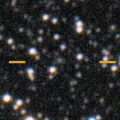
|
Now it is 17.4 mag (Oct. 2, Toshihiko Ikemura, Hirohisa Sato). It stays observable at 17-18 mag for a long time from 2021 to 2022.
Date(TT) R.A. (2000) Decl. Delta r Elong. m1 Best Time(A, h)
Oct. 9 19 14.99 -18 57.3 3.928 4.088 92 17.8 18:57 ( 15, 35)
Oct. 16 19 19.29 -18 53.7 4.027 4.084 86 17.8 18:48 ( 19, 34)
|
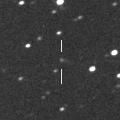
|
Now it is 17.4 mag (Sept. 29, ATLAS-HKO, Haleakala). It will brighten up to 14 mag in early 2023. It stays observable in good condition for a long time until spring.
Date(TT) R.A. (2000) Decl. Delta r Elong. m1 Best Time(A, h)
Oct. 9 4 54.98 3 29.9 4.914 5.493 120 17.9 3:45 ( 0, 59)
Oct. 16 4 54.53 3 16.0 4.786 5.448 127 17.8 3:17 ( 0, 58)
|
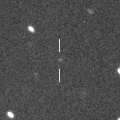
|
Now it is 18.1 mag (Oct. 2, Toshihiko Ikemura, Hirohisa Sato). It has passed the perihelion in 2020 October. At the discovery in 2005, it stayed bright for several years even after the perihelion passage. In this apparition, it may stay observable at 18 mag from 2021 to 2024.
Date(TT) R.A. (2000) Decl. Delta r Elong. m1 Best Time(A, h)
Oct. 9 23 20.17 -29 29.3 3.234 4.026 137 17.8 22:07 ( 0, 26)
Oct. 16 23 17.83 -29 17.8 3.319 4.048 131 17.9 21:37 ( 0, 26)
|

|
Now it is 18.1 mag (Oct. 3, Michael Jager). Main-belt asteroid, but it has a long tail of 10 arcmin. It stays observable in good condition until winter.
Date(TT) R.A. (2000) Decl. Delta r Elong. m1 Best Time(A, h)
Oct. 9 23 41.25 -2 2.8 1.536 2.495 159 19.5 22:28 ( 0, 53)
Oct. 16 23 37.76 -2 25.5 1.585 2.506 151 19.7 21:57 ( 0, 53)
|
|
![]()
 241P/LINEAR
241P/LINEAR C/2020 U4 ( PanSTARRS )
C/2020 U4 ( PanSTARRS ) C/2021 O3 ( PanSTARRS )
C/2021 O3 ( PanSTARRS ) C/2017 U7 ( PanSTARRS )
C/2017 U7 ( PanSTARRS ) 2012 US136
2012 US136 230P/LINEAR
230P/LINEAR 119P/Parker-Hartley
119P/Parker-Hartley 430P/2021 Q2 ( Scotti )
430P/2021 Q2 ( Scotti ) C/2021 P4 ( ATLAS )
C/2021 P4 ( ATLAS ) C/2020 S3 ( Erasmus )
C/2020 S3 ( Erasmus ) 424P/2021 L5 ( La Sagra )
424P/2021 L5 ( La Sagra ) 395P/2020 H1 ( Catalina-NEAT )
395P/2020 H1 ( Catalina-NEAT ) C/2020 S4 ( PanSTARRS )
C/2020 S4 ( PanSTARRS ) 378P/2019 E2 ( McNaught )
378P/2019 E2 ( McNaught ) 433P/(248370) 2005 QN173
433P/(248370) 2005 QN173![]()








































































